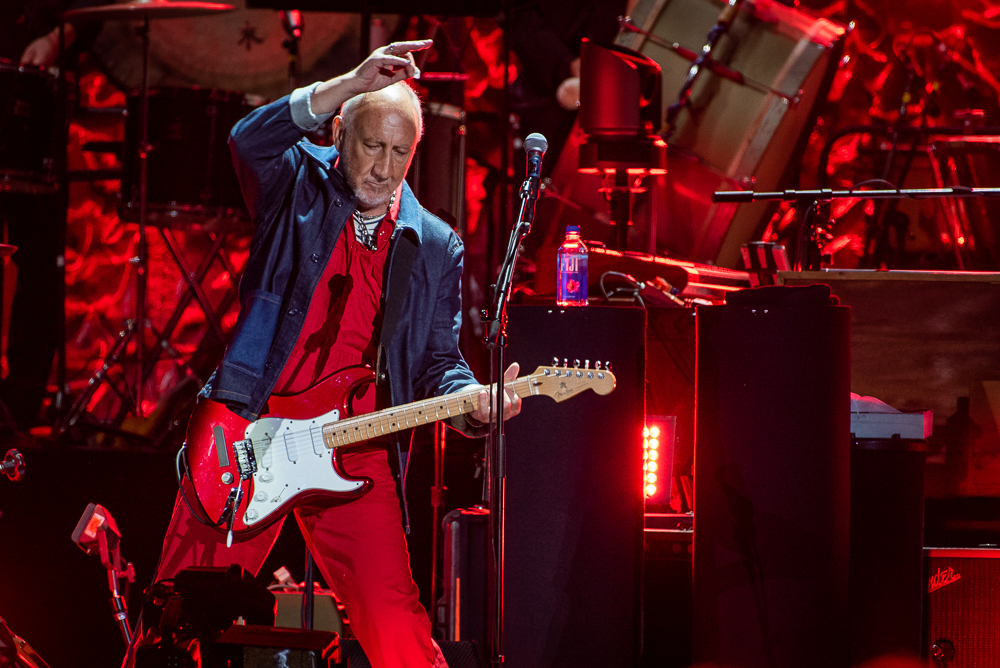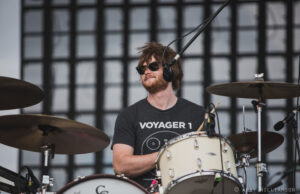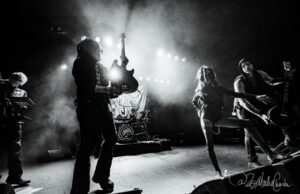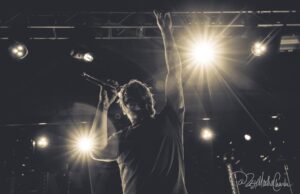Who We Are: The Who at T-Mobile Park

Pete Townshend of The Who is, among so many other things, a fashion icon. There really is no other way to explain the sudden surge in coveralls, jumpsuits, and boiler suits this year. Townshend donned his own again for the band’s Moving On tour after many, many years of not wearing them. Dickies introduced women’s boilersuits for the first time this fall, including a fiery red matching Townshend’s current favorite hue. The Who has influenced pop culture for over five decades, and that isn’t going to stop anytime soon. We are The Who.
As my dear friend Jim and I wriggled our way through the crowd to our seats at the band’s Seattle performance at T-Mobile Park (a crowd that was spilling into the aisles and basically unaware that we even existed), we saw faces that ranged through the ages. Teenagers headbanged to “Substitute,” a song that was released in 1966 and hasn’t lost any relevancy in the intervening years. One can easily imagine those kids identifying with the sentiment “substitute you for my mom/ at least I’ll get my washing done.” People in their thirties and forties were dancing whilst bouncing a running commentary back and forth (‘Roger sounds amazing,’ ‘That dude on keys is fantastic’).
Every single person was engaged with what was happening on stage during The Who’s two hour plus set. Every windmill and mic swing was greeted with a mighty roar. Every lyric echoed thousands of times over, Roger Daltrey’s hearty voice soaring over them all. The Who opened their two hour spanning set with “Overture” from Tommy, which led off a large clutch of music from that album. That and the selections taken from Quadrophenia were elevated by the inclusion of a full orchestra (John Entwistle would have approved). The sound from the floor was good. From the back it seemed a bit boomy, but the roof over the stadium and the placement of the stage, which essentially cut the size of the venue in half, helped ameliorate a problem that has seemed to plague this tour, namely that orchestras are best heard in smaller venues with better acoustics. Zak Starkey was outfitted with a full drum kit; each individual drum was outfitted with an electronic cover in order to dampen the sound and not drown out the orchestra, which had also been bemoaned on previous shows but didn’t seem to cause issues in this case, because he sounded excellent.
Daltrey’s voice, as noted earlier, was in fine form. It’s a safe bet that if it had been a few degrees warmer in the outdoor venue, he would have bared his chest just like he did decades ago. Townshend lived up to his legendary stage presence; of course he didn’t jump as much as he has in years past, but he made up for it by attacking his guitar as fiercely as ever. It’s safe to say that I have never seen another guitar player play the way that Pete Townshend does. He rained blows upon the strings, used the microphone stand repeatedly as a guitar slide, and sawed ferociously across the bridge with his pick, also blunting the edge of the pick on the metal covering the end of the bridge before sawing again on the strings, something that left marks on the chrome for the rest of the show.
The stage setup for this tour was less opulent than those of the past few years, but that was just fine as it allowed the crowd to focus on the band rather than on any extraneous videos and imagery. The set list didn’t reach back much further than “Substitute” (no “My Generation,” sorry), but there was a fantastic rendition of “I Can See For Miles,” as well as an acoustic version of “Won’t Get Fooled Again” with just Daltrey and Townshend. The deepest cut came from The Who By Numbers; the ballad “Imagine A Man” was a bit of a downer but still interesting to hear live (I would have preferred to hear “However Much I Booze” or “How Many Friends” from that album, but I digress). Two new tracks were trotted out. “Hero Ground Zero” oddly worked very well coming after “Imagine A Man” and “Ball and Chain” also had a more subdued reception (which Townshend predicted).
Townshend is a salty person; he had the crowd laughing throughout the show, at one time suggesting that everyone buy their grandfather their upcoming album, WHO, or perhaps “get him what he really wants: a new grandma.” He also lovingly called his brother, Simon Townshend (playing second guitar), a “cunt,” which caused an uproar of guffaws. Daltrey was effusive about the band’s “fuckups” during the set, musing that they were what made live songs special and memorable. It was obvious to everyone that the duo still enjoys the stage, any protesting to the opposite aside.
This being the Pacific Northwest, it was a surprise to absolutely no one when Pearl Jam’s Eddie Vedder skipped onstage in a Union Jack jacket and sang “The Punk and The Godfather” along with Daltrey during the Quadrophenia portion of the night. That didn’t mean that it wasn’t cool. It was also a treat to hear Townshend sing a couple of tracks, with “I’m One” the highlight over “Eminence Front.”
The marathon performance concluded with “Baba O’Riley,” and the entire venue was on its feet, screaming and hollering for the band to keep going. It wasn’t meant to be; the house lights came up and the magic was over. I had to go home and take off my boilersuit and go to sleep.























































0 comments